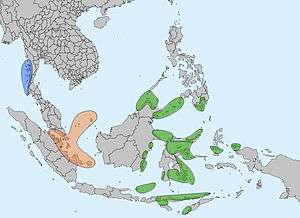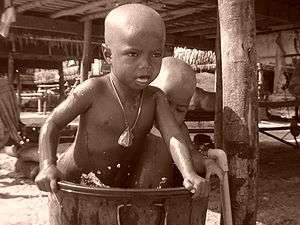Moken people
|
Moken children near Surin Island, Thailand. | |
| Total population | |
|---|---|
| (2,000-3,000) | |
| Regions with significant populations | |
| Southern Thailand, Southern Burma | |
| Languages | |
| Moken, Thai, Burmese, others | |
| Religion | |
| Traditional religion, Buddhism | |
| Related ethnic groups | |
| Malay, Orang laut |

The Moken (also spelled Mawken or Morgan; Burmese: ဆလုံလူမျိုး; Thai: ชาวเล, chao le "sea people"), are an Austronesian ethnic group with about 2,000 to 3,000 members who maintain a nomadic, sea-based culture. They speak their own language which belongs to the Austronesian language family.[2]
Nomenclature
They refer to themselves as Moken. The name is used for all of the Austronesian speaking tribes who inhabit the coast and islands in the Andaman Sea on the west coast of Thailand, the provinces of Satun, Trang, Krabi, Phuket, Phang Nga, and Ranong, up through the Mergui Archipelago of Burma (Myanmar). The group includes the Moken proper, the Moklen (Moklem), the Orang Sireh (Betel-leaf People), and the Orang Lanta. The last, the Orang Lanta, are a hybridized group formed when the Malay people settled the Lanta islands where the proto-Malay Orang Sireh had been living.
The Burmese call the Moken Selung, Salone, or Chalome.[3] In Thailand they are called Chao Ley (people of the sea) or Chao nam (people of the water), although these terms are also used loosely to include the Urak Lawoi and even the Orang Laut. In Thailand, acculturated Moken are called Thai Mai (new Thais).
The Moken are also called Sea Gypsies, a generic term that applies to a number of peoples in southeast Asia. The Urak Lawoi are sometimes classified with the Moken, but they are linguistically and ethnologically distinct, being much more closely related to the Malay people.[4][5]
Way of life

Their knowledge of the sea enables them to live off its fauna and flora by using simple tools such as nets and spears to forage for food. What is not consumed is dried atop their boats, then used to barter for other necessities at local markets. During the monsoon season, they build additional boats while occupying temporary huts. Because of the amount of time they spend diving for food, Moken children are able to see better underwater due to accommodation of their visual focus.[6][7]
Some of the Burmese Moken are still nomadic people who roam the sea most of their lives in small hand-crafted wooden boats called kabang, which serve not just as transportation, but also as kitchen, bedroom, and living area. However, much of their traditional life, which is built on the premise of life as outsiders, is under threat and appears to be diminishing.
Governmental control
The Burmese and Thai governments have made attempts at assimilating the people into their own culture, but these efforts have met with limited success. Thai Moken have been permanently settled in villages located in the Surin Islands (Mu Ko Surin National Park),[8][9] in Phuket Province, on the northwestern coast of Phuket Island, and on the nearby Phi Phi islands of Krabi province.[10]
The Andaman Sea off the Tenasserim coast was the subject of keen scrutiny from Burma's regime during the 1990s due to offshore petroleum discoveries by multinational corporations including Unocal, Petronas and others. Reports from the late 1990s told of forced relocation by Burma's military regime of the 'Sea Gypsies' to on-land sites. It was claimed most of the Salone had been relocated by 1997, which is consistent with a pervasive pattern of forced relocation of suspect ethnic, economic and political groups, conducted throughout Burma during the 1990s.
2004 Indian Ocean Tsunami
The islands where the Moken live received much media attention in 2005 during the Southeast Asia Tsunami recovery, where hundreds of thousands of lives were lost in the disaster. As they are keenly aware of the sea, the Moken in some areas knew the tsunami that struck on December 26, 2004 was coming,[11] and managed to preserve many lives.
However, in the coastal villages of Phang Nga Province, like Tap Tawan, the Moken suffered severe devastation to housing and fishing boats in common with other Moken communities.[12]
See also
Notes
- ↑ David E. Sopher (1965). "The Sea Nomads: A Study Based on the Literature of the Maritime Boat People of Southeast Asia". Memoirs of the National Museum. 5: 389–403. doi:10.2307/2051635.
- ↑ Some classifications do not include Moken under the Malayan languages, or even under the Aboriginal Malay group of languages. "Ethnologue report for Moken/Moklen" Ethnologue. Moken is considered part of, but isolated within the (Nuclear) Malayo-Polynesian family, displaying no particular affinities to any other (Nuclear) Malayo-Polynesian language. Moreover, it has undergone strong areal influence from neighbouring Mon–Khmer languages, comparable to, but apparently independently from the Chamic languages.
- ↑ Anderson, John (1890). The Selungs of the Mergui Archipelago. London: Trübner & Co. pp. 1–5.
- ↑ Classification of Urak Lawoi language
- ↑ Dr. Supin Wongbusarakum (December 2005). "Urak Lawoi of the Adang Archipelago, Tarutao National Marine Park, Satun Province, Thailand" (Microsoft Word).
- ↑ Gislén, Anna (May 13, 2003) "Superior Underwater Vision in a Human Population of Sea Gypsies" Current Biology 13(10): pp. 833–836;
- ↑ Travis, J. (May 17, 2003) "Children of Sea See Clearly Underwater" Science News 163(20): pp. 308–309;
- ↑ Environmental, social and cultural settings of the Surin Islands
- ↑ "Mu Ko Surin National Park" National Park, Wildlife and Plant Conservation Department, Bangkok, Thailand;
- ↑ Bauerlein, Monika (November 2005) "Sea change: they outsmarted the tsunami, but Thailand's sea gypsies could be swept away by an even greater force" Mother Jones 30(6): pp. 56–61;
- ↑ Leung,Rebecca (25 December 2005). "Sea Gypsies See Signs In The Waves". 60 Minutes. CBS News.
- ↑ Jones, Mark (6 May 2005). "Thailand's fisherfolk rebuild after tsunami". Reuters. also from Web Archive
Further reading
- Bernatzik, H. A., & Ivanoff, J. (2005). Moken and Semang: 1936–2004, persistence and change. Bangkok: White Lotus. ISBN 974-480-082-8
- Ivanoff, J. (2001). Rings of coral: Moken folktales. Mergui archipelago project, no. 2. Bangkok, Thailand: White Lotus Press. ISBN 974-7534-71-1
- Ivanoff, J. (1999). The Moken boat: symbolic technology. Bangkok: White Lotus Press. ISBN 974-8434-90-7
- Ivanoff, J., Cholmeley, F. N., & Ivanoff, P. (1997). Moken: sea-gypsies of the Andaman Sea, post-war chronicles. Bangkok: Cheney. ISBN 974-8496-65-1
- Lewis, M. B. (1960). Moken texts and word-list; a provisional interpretation. Federation museums journal, v.4. [Kuala Lumpur]: Museums Dept., Federation of Malaya.
- White, W. G. (1922). The sea gypsies of Malaya; an account of the nomadic Mawken people of the Mergui Archipelago with a description of their ways of living, customs, habits, boats, occupations, etc. London: Seeley, Service & Co.
- White, W. G. (1911). An introduction to the Mawken language. Toungoo: S.P.G. Press.
External links
| Wikimedia Commons has media related to Moken. |
- "The Sea Gypsies" (CBS-TV; 60 Minutes; 2005).
- Salons: Sea Gypsies @ Enchanting Myanmar
- Moken: Sea Gypsies @ National Geographic (Subscription Required)
- Moken: Sea Gypsies @ National Geographic (Tsunami Extra)
- Phuket Magazine: The Moken – Traditional Sea Gypsies
- ProjectMaje.org – Burma "Sea Gypsies" Compendium
- Moken language and verbs
- Ethnologue report for Moken
- The Sea Gypsies of Surin Island – Expeditions, Research in Applied Anthropology
- "The Sea Gypsies of Surin Island" by Antonio Graceffo
- Tourist view on the Moken in Burma/Myanmar
- Ten most frequently asked questions about the Moken
- images of Moken children underwater
- Moken-Video-NAG
- Helping the Moken in Myanmar (Burma)
- A reading list of books on the Moken and the Mergui Archipelago
- Moken music, Archive.org
- How Moken children see with amazing clarity underwater - Inside the Human Body - BBC One
